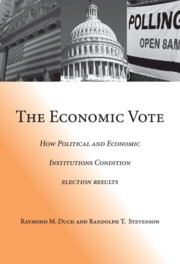Book contents
- Frontmatter
- Contents
- Preface
- 1 Introduction
- Part I Describing the Economic Vote in Western Democracies
- 2 Defining and Measuring the Economic Vote
- 3 Patterns of Retrospective Economic Voting in Western Democracies
- 4 Estimation, Measurement, and Specification
- Part II A Contextual Theory of Rational Retrospective Economic Voting: Competency Signals
- Part III A Contextual Theory of Rational Retrospective Economic Voting: Strategic Voting
- Part IV Conclusion and Summary
- Appendix A
- Appendix B
- Appendix C
- References
- Index
- Cambridge Cultural Social Studies
4 - Estimation, Measurement, and Specification
Published online by Cambridge University Press: 06 July 2010
- Frontmatter
- Contents
- Preface
- 1 Introduction
- Part I Describing the Economic Vote in Western Democracies
- 2 Defining and Measuring the Economic Vote
- 3 Patterns of Retrospective Economic Voting in Western Democracies
- 4 Estimation, Measurement, and Specification
- Part II A Contextual Theory of Rational Retrospective Economic Voting: Competency Signals
- Part III A Contextual Theory of Rational Retrospective Economic Voting: Strategic Voting
- Part IV Conclusion and Summary
- Appendix A
- Appendix B
- Appendix C
- References
- Index
- Cambridge Cultural Social Studies
Summary
The evidence presented in the previous chapter established that economic voting in the world's advanced democracies is both pervasive and variable. The goal of the rest of this book is to identify the political and economic contexts that explain that variation. To do so, we develop a contextual theory of rational retrospective economic voting that points to specific kinds of political and economic institutions as the likely sources of cross-national and temporal variation in economic voting. However, before we make the effort to develop that theory and test its implications, we need first to establish that the variation in our estimates of economic voting described in the last chapter cannot be explained away as an artifact of the empirical methods we have employed to generate them. Three general methodological issues are of concern here: the choice of statistical models, measurement decisions, and model specification. We begin with an explanation of the two main statistical methods we use to conduct the empirical analysis in this and subsequent chapters. We then proceed to analyze our data to determine whether our estimated variation in the economic vote is an artifact of our particular statistical models, measurement choices, or specification decisions.
Two Methods for Exploring the Sources of Contextual Variation in the Economic Vote
In this section, we introduce two general empirical methodologies for testing hypotheses about the impact of contextual variables on individual-level behavioral relationships: The first is a one-stage approach in which the individual-level data from multiple contexts (in our case, voter-preference surveys) are pooled and the impact of context is estimated simultaneously with the individual behavioral relationships of interest.
- Type
- Chapter
- Information
- The Economic VoteHow Political and Economic Institutions Condition Election Results, pp. 94 - 128Publisher: Cambridge University PressPrint publication year: 2008



